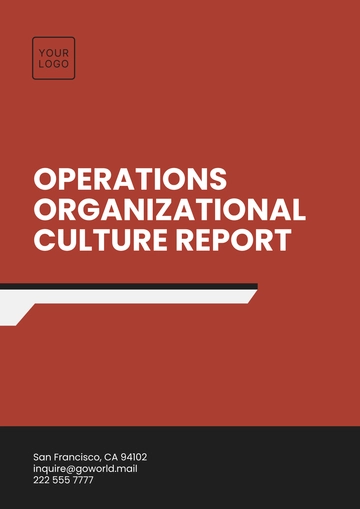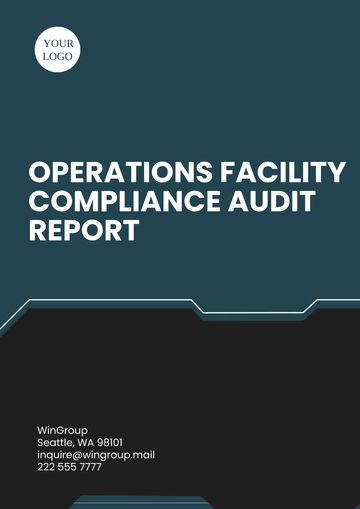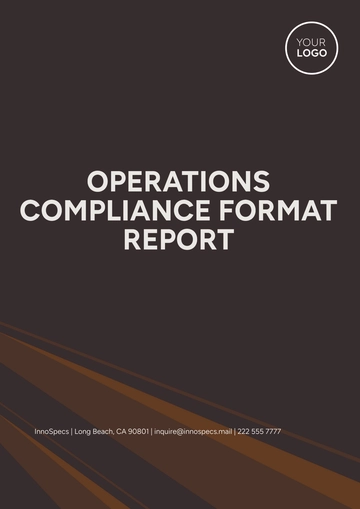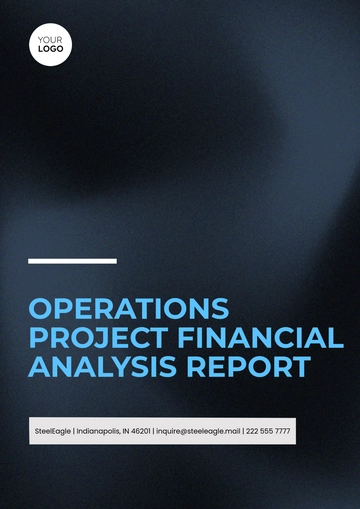Free Operations Environmental Sustainability Report

[Your Company Name]
[Your Company Address]
I. Executive Summary
This report offers an overview of our company's environmental sustainability performance, outlining our fundamental strategy and highlighting the achieved goals. [Your Company Name] is dedicated and focused on reducing waste, conserving resources, and managing emissions.
Our key sustainability highlights of the year are:
Reduced overall energy consumption by 20%
Increased waste recycling by 30%
Decreased emissions by 15%
Implemented a new sustainable supply chain management system
Maintained full compliance with all environmental laws and regulations
II. Environmental Policy and Management Approach
The company's environmental policy is rooted in responsible stewardship, efficiency and reduction of waste. The management structure in place is designed to seamlessly integrate these objectives into all areas of operations.
Our key management approaches include:
Defining clear roles and responsibilities for sustainability
Training employees on sustainability practices
Engaging with stakeholders on our environmental performance
Establishing measurable targets for improvement
Regular reviews and adjustments to our strategy as necessary
III. Energy Use and Efficiency
Energy Source | Consumption (in units) | Conservation Measures |
|---|---|---|
Electricity | 500,000 | LED lights implementation, energy-efficient equipment |
Natural Gas | 120,000 | Improved insulation, equipment upgrades |
Oil | 50,000 | Replacement with more efficient fuel types |
Renewables | 150,000 | Increase in investment in renewable sources |
IV. Emissions, Effluents, and Waste Management
[Your Company Name] is committed to reducing the environmental impact of our operations. In 2021, we managed to reduce our carbon emissions by 15%, increase our recycling rate by 30% and limit the generation of waste.
We achieved these improvements by improving our operations, implementing innovative technologies, and using resources more efficiently. We also engaged our employees in our sustainability efforts, helping to instill a culture of environmental responsibility throughout the organization.
V. Water Conservation
At [Your Company Name], we recognize the critical importance of conserving water to ensure environmental sustainability and compliance with US regulations. Our comprehensive water conservation strategy focuses on minimizing consumption, enhancing water use efficiency, and promoting sustainable practices across all operations. This approach is divided into three key areas:
Water Recycling and Reuse: Implementing systems to treat and reuse water within our operations, significantly reduces our demand for local water resources.
Efficient Water Management: Upgrading to water-efficient fixtures and implementing strict water use monitoring to decrease overall consumption.
Community and Ecosystem Support: Engaging in initiatives that support local water conservation efforts and contribute to the health of the ecosystems we operate in, ensuring our activities promote water sustainability both within and outside our company boundaries.
VI. Materials and Supply Chain Management
[Your Company Name] prioritizes sustainable materials and supply chain management as a cornerstone of our environmental commitment. By integrating eco-friendly practices throughout our supply chain, we aim to reduce our environmental footprint and promote sustainability. This multifaceted approach is structured around five key areas:
Sustainable Sourcing: Selecting materials from suppliers who adhere to environmental standards and practices, ensuring the sustainability of our raw materials.
Supplier Environmental Assessments: Conduct thorough environmental impact assessments of our suppliers to encourage and ensure their commitment to sustainability aligns with our standards.
Efficiency in Logistics: Optimizing transportation routes and methods to minimize emissions and energy use associated with the movement of goods.
Waste Reduction in Production: Implementing processes that minimize waste production through efficient material use and promoting recycling and reuse of materials wherever possible.
Product Life-Cycle Analysis: Evaluating the environmental impact of our products throughout their life cycle to identify opportunities for improvement and ensure end-to-end sustainability.
VII. Biodiversity and Land Use
Initiative | Description | Impact |
|---|---|---|
Habitat Restoration | Restoring degraded lands and habitats to their natural state. | Enhanced local biodiversity, and improved ecosystem services. |
Sustainable Land Management | Implementing practices that reduce soil erosion and degradation. | Preserved land quality, and supported ecosystem resilience. |
Biodiversity Monitoring | Regular assessment of local wildlife and plant species. | Informed conservation strategies, and minimized operational impact on ecosystems. |
Eco-friendly Infrastructure | Designing facilities to minimize environmental disruption. | Reduced habitat fragmentation, and maintained natural landscapes. |
Community Engagement | Collaborating with local communities on conservation projects. | Strengthened ecosystem protection, and increased biodiversity awareness. |
VIII. Social and Community Engagement
At [Your Company Name], we deeply value our role and impact within the communities we operate. Our approach to social and community engagement is built on fostering strong, positive relationships and contributing to the well-being of local communities through sustainable practices. We focus our efforts on three key areas:
Community Partnerships: Collaborating with local organizations and stakeholders to support community-driven environmental initiatives.
Education and Awareness: Offering educational programs and resources to raise awareness about sustainability and environmental stewardship.
Volunteerism and Philanthropy: Encouraging employee volunteerism and providing financial support to local environmental and social projects.
IX. Environmental Compliance and Governance
[Your Company Name] adheres strictly to environmental compliance and governance, ensuring that our operations not only meet but exceed regulatory standards and best practices for sustainability. Our comprehensive approach is structured around five key pillars:
Regulatory Compliance: Rigorously following environmental laws and regulations at federal, state, and local levels to ensure full compliance.
Environmental Management Systems (EMS): Implementing EMS to systematically manage our environmental impacts and improve environmental performance.
Sustainability Reporting: Regularly publishing detailed reports on our environmental performance and sustainability efforts to maintain transparency with stakeholders.
Stakeholder Engagement: Engaging with stakeholders, including investors, customers, and communities, to gather feedback and align our sustainability strategies with their expectations.
Continuous Improvement: Committing to ongoing assessment and improvement of our environmental policies, practices, and goals to enhance our sustainability performance over time.
X. Future Goals and Targets
[Your Company Name] is dedicated to ambitious sustainability goals, aiming to cut carbon emissions, boost energy efficiency, and use more renewable energy. We strive to lead in environmental stewardship by expanding water conservation, reducing waste, and enhancing supply chain sustainability. Our clear, measurable targets will minimize our environmental impact and drive sustainable growth, reflecting our commitment to a positive planetary and societal impact.
- 100% Customizable, free editor
- Access 1 Million+ Templates, photo’s & graphics
- Download or share as a template
- Click and replace photos, graphics, text, backgrounds
- Resize, crop, AI write & more
- Access advanced editor
Advance your startup's eco-initiatives with the Operations Environmental Sustainability Report Template from Template.net. This template is both editable and customizable, perfect for documenting your commitment to sustainability. Specifically designed to be editable in our Ai Editor Tool, it assists in creating a detailed account of your environmental efforts, showcasing your dedication to sustainable practices.
You may also like
- Sales Report
- Daily Report
- Project Report
- Business Report
- Weekly Report
- Incident Report
- Annual Report
- Report Layout
- Report Design
- Progress Report
- Marketing Report
- Company Report
- Monthly Report
- Audit Report
- Status Report
- School Report
- Reports Hr
- Management Report
- Project Status Report
- Handover Report
- Health And Safety Report
- Restaurant Report
- Construction Report
- Research Report
- Evaluation Report
- Investigation Report
- Employee Report
- Advertising Report
- Weekly Status Report
- Project Management Report
- Finance Report
- Service Report
- Technical Report
- Meeting Report
- Quarterly Report
- Inspection Report
- Medical Report
- Test Report
- Summary Report
- Inventory Report
- Valuation Report
- Operations Report
- Payroll Report
- Training Report
- Job Report
- Case Report
- Performance Report
- Board Report
- Internal Audit Report
- Student Report
- Monthly Management Report
- Small Business Report
- Accident Report
- Call Center Report
- Activity Report
- IT and Software Report
- Internship Report
- Visit Report
- Product Report
- Book Report
- Property Report
- Recruitment Report
- University Report
- Event Report
- SEO Report
- Conference Report
- Narrative Report
- Nursing Home Report
- Preschool Report
- Call Report
- Customer Report
- Employee Incident Report
- Accomplishment Report
- Social Media Report
- Work From Home Report
- Security Report
- Damage Report
- Quality Report
- Internal Report
- Nurse Report
- Real Estate Report
- Hotel Report
- Equipment Report
- Credit Report
- Field Report
- Non Profit Report
- Maintenance Report
- News Report
- Survey Report
- Executive Report
- Law Firm Report
- Advertising Agency Report
- Interior Design Report
- Travel Agency Report
- Stock Report
- Salon Report
- Bug Report
- Workplace Report
- Action Report
- Investor Report
- Cleaning Services Report
- Consulting Report
- Freelancer Report
- Site Visit Report
- Trip Report
- Classroom Observation Report
- Vehicle Report
- Final Report
- Software Report





























